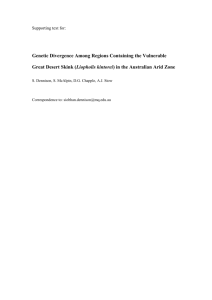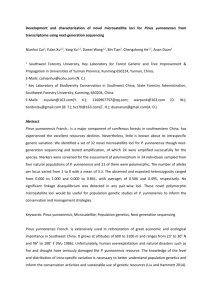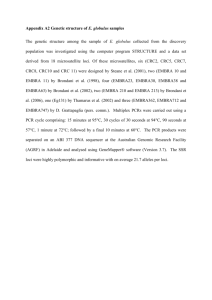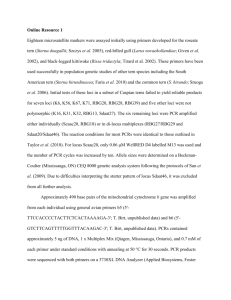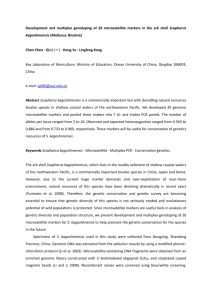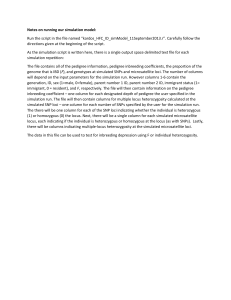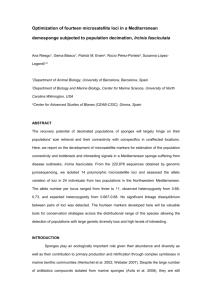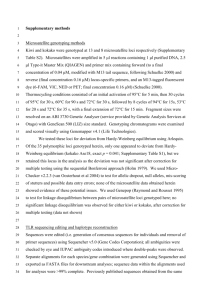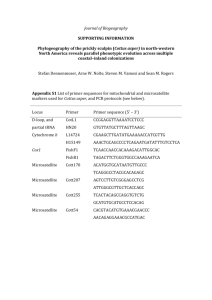mec13049-sup-0001-SuppInfo
advertisement
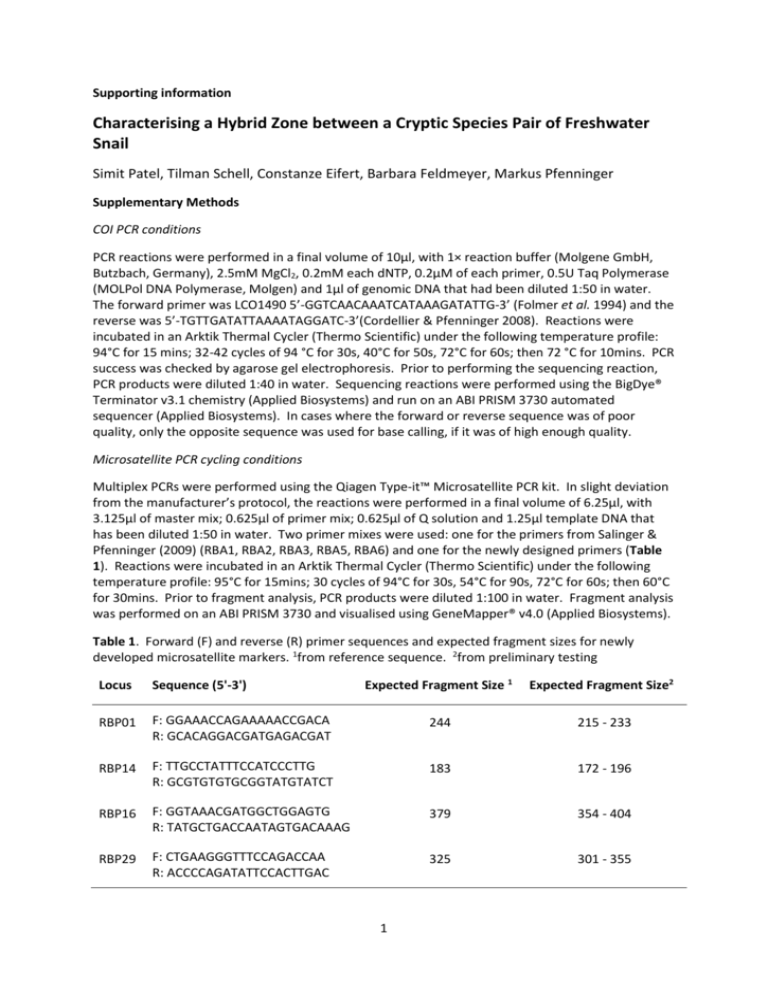
Supporting information Characterising a Hybrid Zone between a Cryptic Species Pair of Freshwater Snail Simit Patel, Tilman Schell, Constanze Eifert, Barbara Feldmeyer, Markus Pfenninger Supplementary Methods COI PCR conditions PCR reactions were performed in a final volume of 10µl, with 1× reaction buffer (Molgene GmbH, Butzbach, Germany), 2.5mM MgCl2, 0.2mM each dNTP, 0.2µM of each primer, 0.5U Taq Polymerase (MOLPol DNA Polymerase, Molgen) and 1µl of genomic DNA that had been diluted 1:50 in water. The forward primer was LCO1490 5’-GGTCAACAAATCATAAAGATATTG-3’ (Folmer et al. 1994) and the reverse was 5’-TGTTGATATTAAAATAGGATC-3’(Cordellier & Pfenninger 2008). Reactions were incubated in an Arktik Thermal Cycler (Thermo Scientific) under the following temperature profile: 94°C for 15 mins; 32-42 cycles of 94 °C for 30s, 40°C for 50s, 72°C for 60s; then 72 °C for 10mins. PCR success was checked by agarose gel electrophoresis. Prior to performing the sequencing reaction, PCR products were diluted 1:40 in water. Sequencing reactions were performed using the BigDye® Terminator v3.1 chemistry (Applied Biosystems) and run on an ABI PRISM 3730 automated sequencer (Applied Biosystems). In cases where the forward or reverse sequence was of poor quality, only the opposite sequence was used for base calling, if it was of high enough quality. Microsatellite PCR cycling conditions Multiplex PCRs were performed using the Qiagen Type-it™ Microsatellite PCR kit. In slight deviation from the manufacturer’s protocol, the reactions were performed in a final volume of 6.25µl, with 3.125µl of master mix; 0.625µl of primer mix; 0.625µl of Q solution and 1.25µl template DNA that has been diluted 1:50 in water. Two primer mixes were used: one for the primers from Salinger & Pfenninger (2009) (RBA1, RBA2, RBA3, RBA5, RBA6) and one for the newly designed primers (Table 1). Reactions were incubated in an Arktik Thermal Cycler (Thermo Scientific) under the following temperature profile: 95°C for 15mins; 30 cycles of 94°C for 30s, 54°C for 90s, 72°C for 60s; then 60°C for 30mins. Prior to fragment analysis, PCR products were diluted 1:100 in water. Fragment analysis was performed on an ABI PRISM 3730 and visualised using GeneMapper® v4.0 (Applied Biosystems). Table 1. Forward (F) and reverse (R) primer sequences and expected fragment sizes for newly developed microsatellite markers. 1from reference sequence. 2from preliminary testing Expected Fragment Size 1 Expected Fragment Size2 F: GGAAACCAGAAAAACCGACA R: GCACAGGACGATGAGACGAT 244 215 - 233 RBP14 F: TTGCCTATTTCCATCCCTTG R: GCGTGTGTGCGGTATGTATCT 183 172 - 196 RBP16 F: GGTAAACGATGGCTGGAGTG R: TATGCTGACCAATAGTGACAAAG 379 354 - 404 RBP29 F: CTGAAGGGTTTCCAGACCAA R: ACCCCAGATATTCCACTTGAC 325 301 - 355 Locus Sequence (5'-3') RBP01 1 Coding gene PCR conditions PCR conditions were the same for all three coding genes. Reactions were performed using the same conditions as described for COI barcoding. The primers used for each gene are shown in table 2. The thermal cycling conditions were 95°C for 5mins; 35 cycles of 95°C for 30s, 58°C for 30s, 72°C for 90s; then 72°C for 10mins. Sanger sequencing was performed as described above for COI barcoding. Table 2. Forward (F) and reverse (R) primer sequences for the three coding genes Gene RBact1a RBHSPA2 RBPsmd2 Sequence (5'-3') F: TGCCCCTGACTCAGTGTATTC R: TGTACAAAGCGGGTCTCTCA F: TGCTAACAAAAATTCATATTAAAAAGC R: GAGATGATTTCCTCGGGTGA F: GGCTCTTGGGGTCATGAGTA R: GAATATGCAGCATCATCCACA 2 Supplementary Results Below is a summary of the preparatory analyses for the nuclear marker data (microsatellites and coding gene sequences). See Table S4 for a summary of the nuclear markers sample sizes per population. Genetic diversity of microsatellite markers The fragment sizes were in the expected range for all nine microsatellite markers (Table S5), but the number of alleles was slightly higher than expected for all nine loci, except RBA1 (five alleles compared to seven in Salinger and Pfenninger 2009). RBA2 was particularly variable (41 alleles, p < 0.01, Grubbs’ test). Fourteen individuals were genotyped at microsatellite loci, for which there was no mitochondrial data. Removal of these 14 individuals made no difference to downstream analyses, so they were included anyway. FIS was significantly deviated from Hardy-Weinberg equilibrium in 14 out of 29 populations tested, all of which were positive (homozygote excess, Table S6). Deviations from Hardy-Weinberg equilibrium were detected at at least one microsatellite locus in 22 out of 29 populations tested (Table S6). Amongst these 22 populations, one to four loci showed significant deviation from Hardy-Weinberg equilibrium, per population. RBP01 was the only locus to show no significant deviation in any population, all other loci showed deviation in at least two populations. Most significantly deviated loci had positive FIS values (homozygote excess), the only exceptions being RBP29 in population CPG and RBP14 in population FCT, which were negative (heterozygote excess). HO was systematically lower than HE at all microsatellite loci, over all populations (mean HO = 0.440, mean HE = 0.757, Table S5). Potential null alleles were detected in some populations, although these are limited to loci also showing deviations from Hardy-Weinberg equilibrium (Table S6). Deviations from Hardy-Weinberg equilibrium and low HO have been reported before and can be attributed to homozygote excess caused by a mixed mating system and partial selfing (Salinger & Pfenninger 2009; Haun et al. 2012), as indicated in our data by widespread positive FIS. The null allele detection method used here relies on patterns of homozygote excess too (van Oosterhout et al. 2004), so the potential null alleles detected here could be false signals caused by genuine, biological homozygote excess. Overall Fst was 0.372, with pairwise Fst ranging from 0.056 to 0.758, all of which were significant (Table S7 and Fig. S5). Nuclear coding gene sequences The number of single nucleotide polymorphism (SNP) sites was high in HSPA2 and Psmd2 coding gene fragments (47 and 46, respectively) compared to act1a (14 SNPs) (Table S5). Indels were found in Psmd2 at 16 sites in total. On closer inspection, the indels were restricted to the first half of the alignment (between positions 50 and 175) and a search for untranslated motifs in ungapped Psmd2 sequences revealed upstream open reading frames and other 5’ untranslated elements in the first half of the sequence. When Psmd2 sequences were searched using tblastx, the hits were for the second half (>180bp) of the coding gene region. This means that the first half of the Psmd2 sequences is likely to be an untranslated region, with indel mutations that are unlikely to cause frameshifts on the second half of the sequence, which is protein coding. SNP data from the whole sequence was used for downstream analysis. Strong recombination was detected in HSPA2 (Rm = 11, p = 0.000; ZZ = 0.1326, p = 0.001, Table S8). Positive, yet non-significant recombination was found in Psmd2 (Rm = 4, p = 0.334; ZZ = 0.0185, p = 0.268). No recombination was detected in act1a (Rm = 0, p = 0.822; ZZ = -0.0188, p = 0.648). Reducing HSPA2 and Psmd2 data sets to non-recombining (NR) blocks (herein referred to as HSPA2NR and Psmd2-NR data sets) slightly reduced the samples sizes, fragment lengths and number of SNPs (Table S5b). The number of unique haplotypes was reduced from 56 to 31 and 54 to 30 for 3 HSPA2 and Psmd2, respectively. No loops were present in the haplotype networks for act1a and HSPA2-NR (Fig. S4). Grouping haplotypes separated by one mutation step resulted in 13 NH groups for HSPA2-NR and Psmd2-NR data sets. See Fig. S4 for NH groupings and Table S9 for haplotype frequencies. NH grouping was not necessary for act1a, as this would have resulted in too few NH groups to be informative. 4 Supplementary Figures (a) (b) N 50km (c) Core Population Set Extended Population Set COI Barcode MOTU2 MOTU3 Nuclear Cluster C1 C2 Fig. S1 (a) Relative frequencies of MOTU2 (orange) and MOTU3 (purple) mitochondrial clades per population. (b) Relative membership coefficients for C1 (blue) and C2 (red) nuclear clusters, as inferred by STRUCTURE assuming K=2 (the most likely number of clusters) averaged across individuals per population. Note the similar geographic restriction of MOTU 3 (purple) and K2 (red) in (a) and (b). (c) STRUCTURE diagram showing relative membership coefficients for C1 and C2 per individual in the core and extended population sets. Each vertical bar represents a different individual. The pie charts below indicate the relative frequencies of mitochondrial clades per population – note that C1 populations (blue) tend to be associated with R. balthica (orange), although this is not absolute. (d) A more detailed look at the nuclear cluster membership coefficients and mitochondrial assignments for each individual in the seven populations with mixed mitochondrial clades. Maps and pie charts for (a) and (b) were generated using the software genGIS (Parks et al. 2013). 5 (a) (b) Nuclear Cluster C1 C2 Fig. S2 STRUCTURE results based on microsatellite data only (excluding three coding genes). (a) Relative membership coefficients for C1 (blue) and C2 (red) nuclear clusters, as inferred by STRUCTURE assuming K=2 (the most likely number of clusters) averaged across individuals per population. (b) STRUCTURE diagram showing relative membership coefficients for C1 and C2 per individual in the core and extended population sets. Each vertical bar represents a different individual. See Fig. S1 for sample site labels. 6 Fig. S3 Compressed neighbor-joining tree based on COI sequences. The values at the nodes show bootstrap support values from 500 replicates. The tree was constructed using the T92+Γ, Tamura 3 substitution model, which was chosen using jModelTest (Posada 2008) and Phyml (Guindon & Gascuel 2003). See Table S2 for outgroups used. 7 5 Fig. S4 Statistical parsimony haplotype networks generated in TCS for (a) act1a (b) HSPA2-NR (nonrecombining data) and (c) Psmd2-NR. The connection limit was set to 8 for HSPA2-NR and Psmd2-NR to include divergent haplotypes into the network and the default 95% limit was sufficient for act1a. Different haplotypes are represented by circles and numbered. The size of the circle is proportional to the frequency of sequences (see Table S9 for frequencies). Haplotype 1 has the highest outgroup probability in all three networks. The lines connecting haplotypes represent mutations and the small open circles represent missing haplotypes. Grey shading in (b) and (c) represent nested haplotype (NH) groupings and are numbered (NH numbers are in square dotted outlines). The broken lines in (c) represent ambiguous connections (loops) that were broken. 8 30 25 20 15 0 5 10 Frequency 0 0.1 0.2 0.3 0.4 0.5 0.6 Pairwise Fst Fig. S5. Frequency distribution of pairwise Fst values shown in Table S7. 9 0.7 0.8 Supplementary Tables Table S1. Sampling site locations and number of individuals identified as different Radix MOTUs and other snails by COI barcoding. Code Sampling site name ALS BLL BSC CMT CPG Aillas Bielle / Castet Biescas Caumont Campagne / Galargues Darnius Dunes / Caudecoste Espiet / Lestrille Foncouverte Feuilla Viviers Gironella Hernani / Ereñozu Isle-Saint-Georges Jurançon L'Esquirol / Sant Martí de Sescorts Le Mouzy Montbazin Orísoain Puyoô / Bellocq DAS DUN ESP FCT FEL FVI GNL HEN ISG JRC LES LMY MBZ ORN PYO Country Latitude Longitude No. R.balthica/MOTU3 Pyrenees (core population set) 0.07222 12/0.42444 11/1 0.32139 -/12 1.08389 5/3 No. MOTU4/MOTU5 Galba sp. Pseudosuccinea columella -/-/-/-/- - - France France France France 44.47417 43.06306 42.62778 43.03222 France 43.78056 4.02694 20/- -/- - - Spain 42.35028 2.86806 15/- -/- 3 - France 44.10639 0.75694 5/3 -/- - - France France France France Spain Spain France France 44.81833 43.16694 42.93056 44.48184 42.03833 43.24444 44.72444 43.27889 0.25472 2.69167 2.90833 4.69706 1.88000 -1.94722 0.47222 0.38889 18/-/20 2/18 7/-/12 2/6 13/5/9 -/-/-/-/-/-/-/-/- 6 - - Spain 42.01528 2.33417 9/- -/- - - France France Spain France 44.15833 43.51333 42.60583 43.52056 1.25139 3.69556 -1.60500 0.91250 3/10 20/10/6/8 -/-/-/-/- - - 10 2.15944 -2.03306 2.67111 3.92139 -1.56056 No. R.balthica/MOTU3 -/2 10/2 -/14 20/6/3 No. MOTU4/MOTU5 -/-/-/-/-/- Galba sp. - Pseudosuccinea columella - 0.83833 -/10 -/- - - Total (core) 199/133 0/0 9 0 Northern Europe (extended population set) 47.77180 5.98470 1/46.49700 7.05000 48/47.35680 5.14590 17/54.36500 10.31600 6/48.64725 7.69000 4/50.00700 9.15601 8/- -/-/-/-/-/-/- - - France 47.15900 -1.48200 3/- -/- - - Great Britain 54.32000 -1.51200 Total (ext) 8/95/0 -/0/0 0 0 Total (core+ext) 294/133 0/0 9 0 6/16/-/14 -/- - - Code Sampling site name Country Latitude Longitude RSL SSB TLR TYR URG VDB Raissac-sur-Lampy Zubieta Talarain Teyran Urguri Vallfogona de Balaguer / Balaguer France Spain France France France 43.27583 43.27417 43.04528 43.68083 43.35639 Spain 41.79583 ABO CSV DIJ DSP LAB MBK POR SWA AGL BGC BZY FCA Aboncourt Lessoc Dijon Passade Lampertheim Glattbach Vertou / La Barbinière Morton-on-Swale L'Agly / Claira Bergerac / Tresses Buzy Les Cabanes France Switzerland France Germany France Germany France France France France Pyrenees (not used in further analysis) 42.75139 2.95278 -/44.84667 0.48861 -/43.12972 0.46139 -/44.09673 4.72692 2/11 1.31056 No. R.balthica/MOTU3 -/- No. MOTU4/MOTU5 9/- Galba sp. - Pseudosuccinea columella - 43.07333 0.39333 -/- -/11 - - France France Spain 44.13583 43.02694 42.00444 0.66611 1.01861 -1.50111 -/-/-/- 5/-/12 3/- 9 - - Spain 41.86000 0.83306 -/- 5/- - - France 43.06583 2.60750 -/1 -/- - - Spain 28.29217 -16.86137 -/- -/- - 12 France 42.64056 2.90417 -/- 21/- - - Spain 41.87389 0.77583 -/- 4/- 1 - Code Sampling site name Country Latitude Longitude GRD LBN Grenade La Barthe-de-Neste / Bas Mour Layrac Prat-Bonrepaux Ribaforada Sant Llorenc de Montagai / Xalets de la Solana St-Pierre-desChamps Teneriffa / Masca Villeneuve-de-laRaho Zuera / La Estación France 43.75083 France LYC PBX RIB SLM SPC TEN VNV ZUE 12 Table S2. Taxon and GenBank Accession numbers for 14 mollusc COI sequences used as outgroups for the neighbour joining tree. Taxon Galba truncatula GenBank-ID FR797873 FR797874 FR797875 Lymnaea stagnalis FR797865 FR797866 FR797867 FR797868 Myxas glutinosa EU818798 Planorbarius corneus FR797857 FR797858 Pseudosuccinea columella JN614404 JN614405 JN614406 AY227366 13 Table S3. Evvano table from Structure Harvester, summarising results used to infer the most likely number of nuclear genetic clusters (K). LnP(K) = posterior likelihood probability; Ln’(K) = mean rate of change of the likelihood distribution across replicates; |Ln''(K)| = mean absolute value of the 2nd order rate of change of the likelihood distribution; ΔK =|Ln''(K)|/sd(L(K)). K=2 (highlighted) has the highest ΔK. Standard Mean Deviation K Replicates LnP(K) LnP(K) Ln'(K) |Ln''(K)| ΔK 1 10 -16967 0.1826 - - - 2 10 -15386.34 96.1767 1580.66 679.97 7.070011 3 10 -14485.65 199.424 900.69 216.45 1.085376 4 10 -13801.41 383.1357 684.24 19.1 0.049852 5 10 -13098.07 309.0838 703.34 - - 14 Table S4. Sample sizes for nine microsatellite loci and three coding genes, per population. Sample sizes for HSPA2 and Psmd2 are the number of individuals in the non-recombinant (NR) data set. The total sample sizes before NR filtering are shown in brackets. Core Population Set ALS BLL BSC CMT CPG DAS DUN ESP FCT FEL FVI GNL HEN ISG JRC LES LMY MBZ ORN PYO RSL SSB TLR TYR URG RBA1 RBA2 RBA3 RBA5 RBA6 11 12 12 8 16 16 8 15 20 13 8 12 8 13 11 9 13 13 10 13 2 10 11 20 11 7 12 12 8 14 16 8 14 20 13 8 12 7 12 12 9 12 14 10 13 2 10 11 20 9 11 12 12 8 16 16 6 15 19 12 8 12 8 12 10 9 13 14 10 13 2 10 11 20 11 11 12 8 8 13 16 6 13 20 13 8 12 8 13 12 9 12 14 10 13 2 10 11 20 11 11 12 12 8 16 15 8 15 20 10 8 12 8 13 12 9 13 14 10 13 2 10 11 20 11 RBP01 RBP14 RBP16 RBP29 RBact1a 11 12 12 8 16 16 8 15 20 13 7 12 8 13 12 9 13 14 10 9 2 10 11 9 11 15 11 12 12 8 16 16 8 15 19 13 8 12 8 13 12 9 13 14 10 13 2 7 11 20 11 11 12 11 8 16 16 8 15 20 13 8 12 8 13 12 9 13 14 9 13 2 9 9 20 11 11 12 12 6 16 16 8 15 20 13 7 12 8 12 12 2 13 14 9 13 2 10 9 20 11 12 12 12 7 16 6 16 1 10 10 12 8 10 13 8 8 13 10 12 2 10 8 15 7 RBHSPA2 RBPsmd2 12 11 11 5 15 14 7 15 18 8 9 11 8 13 13 9 11 8 10 7 2 11 11 13 7 4 12 6 3 11 8 6 6 12 7 5 6 6 8 11 2 7 4 5 11 3 12 17 7 VDB Total (core) Extended Population Set ABO CSV DIJ DSP LAB MBK POR SWA Total (ext) Total (core+ext) RBA1 10 305 RBA2 10 295 RBA3 10 300 RBA5 10 295 RBA6 10 303 1 51 13 4 3 7 3 8 90 395 50 13 4 3 7 2 4 83 378 1 52 13 4 3 7 3 8 91 391 1 50 11 3 3 7 3 8 86 381 1 52 13 4 3 7 3 8 91 394 RBP01 RBP14 RBP16 RBP29 RBact1a 10 10 10 10 291 303 302 293 238 1 48 12 3 3 4 3 8 82 373 16 1 52 13 4 3 6 3 8 90 393 1 52 13 4 3 7 3 8 91 393 1 52 13 3 3 7 2 8 89 382 1 21 9 3 1 2 37 275 RBHSPA2 10 269 (280) RBPsmd2 6 185 (189) 27 7 4 7 3 5 53 (55) 322 (335) 19 6 2 2 7 3 4 43 (43) 228 (232) Table S5. Genetic diversity for (a) microsatellite loci and (b) coding gene sequences. N=sample size; bp = base pair; HE=expected heterozygosity over all populations; HO=observed heterozygosity over all populations; H=number of unique haplotypes; NH=number of nested haplotypes. NR=values for nonrecombinant data sets (for HSPA2 and Psmd2). (a) Microsatellite Locus N No. Populations Fragment size range (bp) HE HO No. Alleles RBA1 395 34 146-156 0.355 0.225 5 RBA2 378 34 293-381 0.957 0.532 41 RBA3 391 34 228-244 0.655 0.325 9 RBA5 381 34 141-207 0.875 0.402 15 RBA6 394 34 357-395 0.832 0.510 15 RBP01 373 34 197-272 0.548 0.448 12 RBP14 393 34 160-212 0.819 0.489 12 RBP16 393 34 352-424 0.887 0.539 18 RBP29 382 34 262-370 0.883 0.487 22 Over all loci 386.7 - - 0.757 0.440 16.6 (b) Coding Genes N (NR) No. Populations Fragment length in bp (NR) No. SNPs (NR) H (NR) NH RBact1a 275 30 359 14 13 - RBHSPA2 335 (332) 32 389 (352) 47 (41) 56 (31) 13 RBPsmd2 232 (228) 32 346 (331) 46 (34) 54 (30) 13 17 Table S6. FIS values per microsatellite locus per population and per population over all loci. Population (Pop) codes as in Table S1. *indicates significantly positive or negative deviation in FIS from Hardy-Weinberg expectations (P≤0.05) as computed in FSTAT. NA = monomorphic loci; - = population excluded; § = potential null alleles detected by Micro-Checker. Pop RBA1 RBA2 RBA3 RBA5 RBA6 RBP01 RBP14 RBP16 RBP29 All ALS 0.024 1*§ 0.137 0.612*§ 0.225 -0.176 0.29 -0.071 0.268 0.237* BLL NA 0.263 0.766* -0.055 0.193 NA 0.035 -0.082 0.542*§ 0.241* BSC 0.203 -0.274 1*§ 0.774 0.006 0.061 0.353 0.828*§ 0.035 0.286* CMT 0 -0.225 0.067 -0.195 CPG -0.034 0.792*§ DAS 0.455 DUN 0.211 -0.2 -0.4 -0.292 0.394 -0.079 NA NA 0.783*§ -0.132 -0.304 -0.08 -0.414* 0.082 0.13 -0.034 NA 0.751*§ NA -0.034 NA 0.257 0.283* -0.424 -0.191 0.75* 0.167 -0.135 0 -0.167 -0.273 0.731*§ 0.04 ESP -0.167 0.3* 0.865*§ 0.64*§ 0.132 -0.143 0.162 -0.201 0.018 0.19* FCT NA 0.17 0.182 0.309 -0.073 0.022 -1* NA -0.107 -0.076 FEL NA 0.723*§ 0.072 0.446 0.845*§ -0.333 -0.143 -0.412 0 0.24* FVI NA -0.077 0.622* 0.103 0.25 -0.358 0.114 -0.094 0.368* 0.12 NA 0.006 GNL 0 NA -0.266 0.126 0.267 1* 0.189 0.118 HEN 1*§ -0.224 1*§ 0.475* -0.296 -0.091 -0.14 -0.191 0.164 0.151* ISG -0.091 0.342*§ 0.447*§ 0.556*§ -0.175 -0.021 -0.143 0.238 0.009 0.193* JRC NA 0.161 -0.043 0.316*§ 0.241 0 0.137 0.091 -0.07 0.118* LES NA NA NA -0.053 -0.143 0.543 0.059 1 0.368 LMY 0.25 NA 0.579*§ 0.497* 0.614*§ -0.116 0 1* 0.138 -0.067 0.314* MBZ -0.043 0 -0.13 -0.011 0.107 -0.064 -0.258 0.576* 0 0.031 ORN NA NA NA 0.617 NA -0.231 0.142 NA PYO NA NA -0.2 0.385*§ 0.277 -0.108 0.168 -0.057 0.146 0.169 0.488*§ 0.188* RSL - - - - - - - - - - SSB -0.339 -0.118 0.419 0.143 -0.083 0.217 0.586*§ 0.529*§ 0.074 0.132* TLR NA -0.429 NA TYR -0.204 0.048 0.2 -0.364 URG -0.053 0.111 0.067 0.444*§ VDB NA 0.154 0.217 0 NA NA NA 0.103 -0.376 -0.186 0.186 -0.412 -0.118 -0.234 0.266 -0.055 0.342* -0.268 0.31 -0.296 0.344*§ 0.143* -0.2 -0.143 0.64 0.386 0.15 0.289 0.145 ABO - - - - - - - - - - CSV 0.21 0.133* -0.085 -0.12 0.072 0.008 -0.008 -0.023 0.114 0.032 DIJ 0.662* -0.169 0 0.2 -0.017 0.043 -0.009 -0.286 0.138 0.035 DSP - - - - - - - - - - LAB - - - - - - - - - - MKB POR SWA NA NA 0.5 -0.532 0.333 1 0.294 0.02 0.192 - - NA - NA - - - - - - 0.217 -0.037 0.659*§ -0.091 0.051 0.116 0.091 0.143 0.168* 18 Table S7. Pairwise FST values Core Population Set SSB HEN ORN URG ALS ESP ISG LMY DUN JRC BLL PYO CMT BSC Extended VDB GNL LES DAS TLR FCT FEL MBZ TYR CPG FVI SWA DIJ CSV HEN 0.232 ORN 0.376 0.347 URG 0.229 0.355 0.498 ALS 0.260 0.312 0.543 0.308 ESP 0.220 0.319 0.441 0.216 0.232 ISG 0.218 0.325 0.460 0.249 0.230 0.056 LMY 0.394 0.377 0.610 0.389 0.296 0.291 0.342 DUN 0.283 0.316 0.598 0.296 0.271 0.239 0.264 0.217 JRC 0.158 0.281 0.426 0.157 0.247 0.163 0.189 0.284 0.176 BLL 0.283 0.413 0.482 0.285 0.410 0.285 0.305 0.468 0.423 0.233 PYO 0.147 0.259 0.365 0.162 0.259 0.140 0.146 0.277 0.201 0.101 0.187 CMT 0.230 0.294 0.433 0.284 0.298 0.191 0.216 0.396 0.321 0.232 0.367 0.204 BSC 0.243 0.250 0.517 0.283 0.316 0.236 0.230 0.355 0.285 0.275 0.308 0.185 0.243 VDB 0.316 0.351 0.536 0.326 0.351 0.302 0.309 0.315 0.273 0.259 0.393 0.184 0.327 0.298 GNL 0.402 0.465 0.601 0.405 0.405 0.310 0.371 0.441 0.386 0.335 0.500 0.335 0.321 0.423 0.281 LES 0.457 0.504 0.710 0.432 0.423 0.341 0.404 0.487 0.382 0.343 0.533 0.359 0.468 0.468 0.315 0.196 DAS 0.526 0.579 0.720 0.514 0.523 0.471 0.516 0.575 0.501 0.449 0.586 0.447 0.561 0.581 0.448 0.450 0.249 TLR 0.475 0.542 0.758 0.516 0.411 0.442 0.423 0.387 0.462 0.400 0.553 0.278 0.541 0.471 0.388 0.577 0.693 0.700 FCT 0.450 0.508 0.671 0.456 0.424 0.385 0.396 0.431 0.384 0.367 0.519 0.328 0.442 0.353 0.364 0.492 0.529 0.644 0.484 FEL 0.463 0.486 0.679 0.387 0.358 0.334 0.362 0.238 0.305 0.330 0.484 0.261 0.439 0.404 0.216 0.413 0.431 0.507 0.390 0.408 MBZ 0.388 0.480 0.606 0.361 0.436 0.358 0.399 0.479 0.398 0.318 0.438 0.273 0.421 0.441 0.392 0.493 0.508 0.545 0.569 0.568 0.470 TYR 0.305 0.404 0.549 0.296 0.317 0.216 0.236 0.443 0.345 0.296 0.377 0.255 0.332 0.292 0.375 0.457 0.424 0.504 0.517 0.468 0.449 0.337 CPG 0.409 0.403 0.602 0.426 0.472 0.418 0.463 0.544 0.506 0.439 0.442 0.353 0.445 0.368 0.483 0.574 0.615 0.648 0.654 0.627 0.608 0.439 0.380 FVI 0.257 0.340 0.537 0.215 0.269 0.199 0.193 0.344 0.275 0.205 0.335 0.081 0.248 0.273 0.237 0.373 0.428 0.475 0.377 0.415 0.294 0.303 0.276 0.438 SWA 0.176 0.307 0.463 0.291 0.315 0.228 0.219 0.392 0.302 0.181 0.307 0.118 0.249 0.272 0.291 0.407 0.472 0.555 0.425 0.426 0.444 0.378 0.322 0.451 0.191 DIJ 0.243 0.348 0.512 0.361 0.359 0.276 0.289 0.382 0.317 0.262 0.285 0.194 0.359 0.305 0.363 0.448 0.490 0.571 0.431 0.505 0.463 0.382 0.372 0.344 0.273 0.231 CSV 0.182 0.255 0.354 0.314 0.328 0.271 0.272 0.356 0.282 0.219 0.283 0.207 0.242 0.264 0.277 0.363 0.393 0.471 0.393 0.407 0.406 0.350 0.356 0.356 0.247 0.221 0.256 MBK 0.346 0.429 0.559 0.443 0.444 0.376 0.400 0.428 0.447 0.326 0.426 0.231 0.417 0.419 0.440 0.534 0.628 0.672 0.552 0.588 0.564 0.527 0.476 0.578 0.377 0.363 0.377 0.295 19 Table S8. Recombination tests for coding gene sequences performed in DNAsp . Average number of site difference (theta) and recombination per gene (R) were used for coalescent simulations. Rm = minimum number of recombination events; P[Rm] = probability of obtaining Rm ≥ observed, given theta and R. ZZ = test statistic for intragenomic recombination (average LD across pairwise comparisons between adjacent sites – average LD across all pairwise comparisons). P[ZZ]= probability of obtaining ZZ ≥ observed, given theta and no recombination. Gene theta R Rm P[Rm] ZZ P[ZZ] RBact1a 1.855 6.3 0 0.822 -0.0188 0.648 RBHSPA2 6.76 2.9 11 0 0.1326 0.001 RBPsmd2 3.801 20.1 4 0.334 0.0185 0.268 Table S9. Haplotype frequencies and nested haplotype (NH) assignments. NH group assignments were for HSPA2-NR (non-recombinant data) and Psmd2-NR only. Frequencies are the number of phased sequences. act1a HSPA2 (NR) Haplotype Frequency Haplotype Frequency 1 273 1 204 2 2 2 2 3 52 3 4 4 2 4 17 5 7 5 6 6 18 6 5 7 42 7 10 8 57 8 3 9 4 9 2 10 4 10 8 11 56 11 16 12 13 12 1 13 20 13 29 14 11 15 1 16 50 17 5 18 1 19 4 20 3 21 1 22 19 23 2 24 7 25 1 26 1 27 44 28 19 29 84 30 1 31 59 Total 550 Total 620 NH 1 1 1 2 2 3 3 4 4 5 6 6 7 7 8 9 9 9 9 10 10 11 11 11 11 11 12 12 13 13 13 20 Haplotype 1 2 3 4 5 6 7 8 9 10 11 12 13 14 15 16 17 18 19 20 21 22 23 24 25 26 27 28 29 30 Psmd2 (NR) Frequency 17 4 14 81 5 1 1 10 1 1 10 4 17 5 6 11 6 7 10 36 2 32 60 3 44 6 15 8 6 17 Total 440 NH 1 1 1 2 2 2 2 3 3 3 4 4 5 5 5 5 6 6 7 7 8 9 10 10 10 11 11 12 12 13 Bibliography Cordellier M, Pfenninger M (2008) Climate-driven range dynamics of the freshwater limpet, Ancylus fluviatilis (Pulmonata, Basommatophora). Journal of Biogeography, 35, 1580–1592. Folmer O, Black M, Hoeh W, Lutz R, Vrijenhoek R (1994) DNA primers for amplification of mitochondrial cytochrome c oxidase subunit I from diverse metazoan invertebrates. Molecular marine biology and biotechnology, 3, 294–299. Guindon S, Gascuel O (2003) A simple, fast, and accurate algorithm to estimate large phylogenies by maximum likelihood. Systematic biology, 52, 696–704. Haun T, Salinger M, Pachzelt A, Pfenninger M (2012) On the processes shaping small-scale population structure in Radix balthica (Linnaeus 1758). Malacologia, 55. Van Oosterhout C, Hutchinson WF, M. WDP, Shiply P (2004) micro-checker: software for identifying and correcting genotyping errors in microsatellite data. Molecular Ecology Notes, 4, 535–538. Parks DH, Mankowski T, Zangooei S et al. (2013) GenGIS 2: geospatial analysis of traditional and genetic biodiversity, with new gradient algorithms and an extensible plugin framework. PloS one, 8, e69885. Posada D (2008) jModelTest: phylogenetic model averaging. Molecular biology and evolution, 25, 1253–1256. Salinger M, Pfenninger M (2009) Highly polymorphic microsatellite markers for Radix balthica (Linnaeus 1758). Molecular ecology resources, 9, 1152–5. 21
